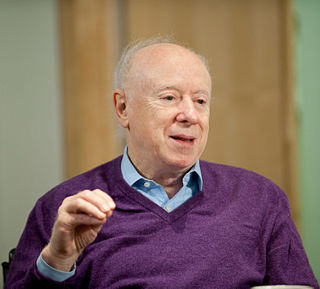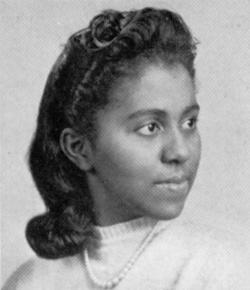
Nacre, also known as mother of pearl, is an organic–inorganic composite material produced by some molluscs as an inner shell layer. It is also the material of which pearls are composed. It is strong, resilient, and iridescent.

Joseph Leonard Goldstein ForMemRS is an American biochemist. He received the Nobel Prize in Physiology or Medicine in 1985, along with fellow University of Texas Southwestern researcher, Michael Brown, for their studies regarding cholesterol. They discovered that human cells have low-density lipoprotein (LDL) receptors that remove cholesterol from the blood and that when LDL receptors are not present in sufficient numbers, individuals develop hypercholesterolemia and become at risk for cholesterol related diseases, notably coronary heart disease. Their studies led to the development of statin drugs.

Limpets are a group of aquatic snails with a conical shell shape (patelliform) and a strong, muscular foot. This general category of conical shell is known as "patelliform" (dish-shaped). Existing within the class Gastropoda, limpets are a polyphyletic group.

Biomineralization, also written biomineralisation, is the process by which living organisms produce minerals, often resulting in hardened or stiffened mineralized tissues. It is an extremely widespread phenomenon: all six taxonomic kingdoms contain members that are able to form minerals, and over 60 different minerals have been identified in organisms. Examples include silicates in algae and diatoms, carbonates in invertebrates, and calcium phosphates and carbonates in vertebrates. These minerals often form structural features such as sea shells and the bone in mammals and birds.

The low-density lipoprotein receptor (LDL-R) is a mosaic protein of 839 amino acids that mediates the endocytosis of cholesterol-rich low-density lipoprotein (LDL). It is a cell-surface receptor that recognizes apolipoprotein B100 (ApoB100), which is embedded in the outer phospholipid layer of very low-density lipoprotein (VLDL), their remnants—i.e. intermediate-density lipoprotein (IDL), and LDL particles. The receptor also recognizes apolipoprotein E (ApoE) which is found in chylomicron remnants and IDL. In humans, the LDL receptor protein is encoded by the LDLR gene on chromosome 19. It belongs to the low density lipoprotein receptor gene family. It is most significantly expressed in bronchial epithelial cells and adrenal gland and cortex tissue.

Marie Maynard Daly was an American biochemist. She was the first African-American to receive a Ph.D. from Columbia University and the first African-American woman in the United States to earn a Ph.D. in chemistry. Daly made important contributions in four areas of research: the chemistry of histones, protein synthesis, the relationships between cholesterol and hypertension, and creatine's uptake by muscle cells.

The molluscshell is typically a calcareous exoskeleton which encloses, supports and protects the soft parts of an animal in the phylum Mollusca, which includes snails, clams, tusk shells, and several other classes. Not all shelled molluscs live in the sea; many live on the land and in freshwater.

Dame Carol Vivien Robinson, is a British chemist and former president of the Royal Society of Chemistry (2018–2020). She was a Royal Society Research Professor and is the Dr Lee's Professor of Physical and Theoretical Chemistry, and a professorial fellow at Exeter College, University of Oxford. She is the founding director of the Kavli Institute for Nanoscience Discovery, University of Oxford, and she was previously professor of mass spectrometry at the chemistry department of the University of Cambridge.

Mineralized tissues are biological tissues that incorporate minerals into soft matrices. Typically these tissues form a protective shield or structural support. Bone, mollusc shells, deep sea sponge Euplectella species, radiolarians, diatoms, antler bone, tendon, cartilage, tooth enamel and dentin are some examples of mineralized tissues.

Amorphous calcium carbonate (ACC) is the amorphous and least stable polymorph of calcium carbonate. ACC is extremely unstable under normal conditions and is found naturally in taxa as wide-ranging as sea urchins, corals, mollusks, and foraminifera. It is usually found as a monohydrate, holding the chemical formula CaCO3·H2O; however, it can also exist in a dehydrated state, CaCO3. ACC has been known to science for over 100 years when a non-diffraction pattern of calcium carbonate was discovered by Sturcke Herman, exhibiting its poorly-ordered nature.

Pupa Gilbert is an American biophysicist and geobiologist. She has been pioneering synchrotron spectromicroscopy methods since 1989, and she continues to use and develop them today. Since 2004 she has focused on biomineralization in sea urchins, mollusk shells, and tunicates. She and her group are frequent users of the Berkeley-Advanced Light Source.
Alice Vrielink is a structural biologist and Professor of Structural Biology in the School of Molecular Sciences at the University of Western Australia. She is known for her work determining the structures of macromolecules such as enzymes and nucleic acids.
Fred Huffman Wilt is an American biologist who was elected a Fellow of the American Association for the Advancement of Science. His research currently includes the endoskeletal spicule of sea urchin embryos, and its biomineralization relative to its cellular and molecular foundation.

Marine biogenic calcification is the production of calcium carbonate by organisms in the global ocean.

Mei Hong is a Chinese-American biophysical chemist and professor of chemistry at the Massachusetts Institute of Technology. She is known for her creative development and application of solid-state nuclear magnetic resonance (ssNMR) spectroscopy to elucidate the structures and mechanisms of membrane proteins, plant cell walls, and amyloid proteins. She has received a number of recognitions for her work, including the American Chemical Society Nakanishi Prize in 2021, Günther Laukien Prize in 2014, the Protein Society Young Investigator award in 2012, and the American Chemical Society’s Pure Chemistry award in 2003.

Patricia Martin Dove is an American geochemist. She is a university distinguished professor and the C.P. Miles Professor of Science at Virginia Tech with appointments in the department of Geosciences, department of Chemistry, and department of Materials Science and Engineering. Her research focuses on the kinetics and thermodynamics of mineral reactions with aqueous solutions in biogeochemical systems. Much of her work is on crystal nucleation and growth during biomineralization and biomaterial interactions with mineralogical systems. She was elected a member of the National Academy of Sciences (NAS) in 2012 and currently serves as chair of Class I, Physical and Mathematical Sciences.
Leslie Leiserowitz is an Israeli chemist and crystallographer.

Susannah M. Porter is an American paleontologist and geobiologist who studies the early evolution of eukaryotes, the early Cambrian fossil record of animals, and the evolution of skeletal biomineralization. She is currently a professor at the University of California, Santa Barbara. Porter is a Fellow of the Paleontological Society. She has received national recognition awards from the Geological Society of America.
Lara Ann Estroff is an American materials scientist who is a professor at Cornell University. Her research considers the study and design of biomaterials.
Julia Mahamid is a cell biologist, structural biologist, and electron microscopist at the European Molecular Biology Laboratory in Heidelberg, Germany, who utilizes biomolecular condensates and advanced cellular cryo-electron tomography to enhance the comprehension of the functional organization of the cytoplasm. She leads the Mahamid Group.















